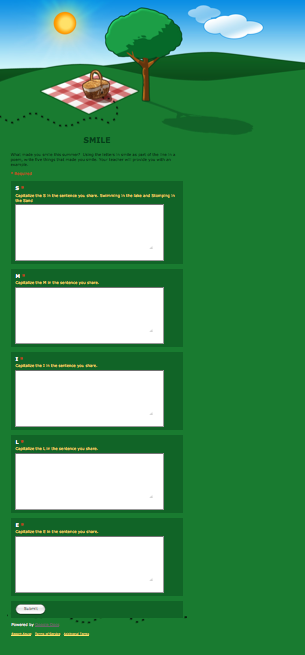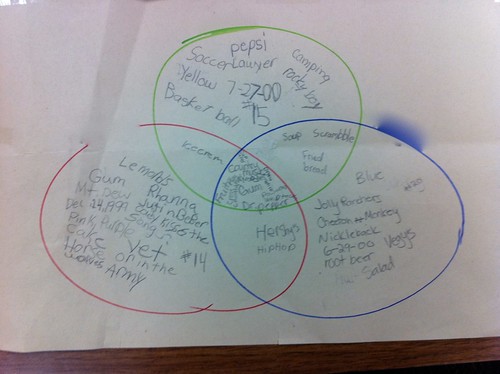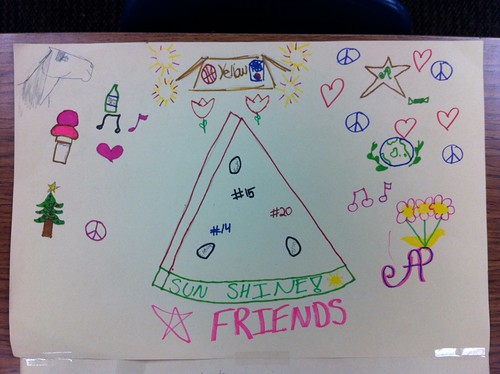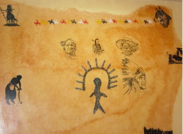Building Community
Without community, a classroom is just a room. Without community, a class is just a crowd.
A community of learners starts with discovering each person's talents and builds on the relationships that develop from respectful discussions and appreciation for the similarities and differences that make our uniqueness add to the day-to-day participation in helping one another learn.
How do we begin discovering who we are as a class?
Here is a summary of six activities to build community and one culminating activity to draw it all together. See more details in other posts at What Else Blog
 1. SMILE:
Ask students what made them smile this summer. Students use the letters to write a poem of the events or people that brought them joy this summer.
1. SMILE:
Ask students what made them smile this summer. Students use the letters to write a poem of the events or people that brought them joy this summer.
While paper will do, I've decided to create a Google Form for students to enter the S M I L E of their summer joys; the summary will show everyone's anonymously. Look for similarities and differences. Further poetry could result from those.
2. FAVORITES
Make a list of favorites: animal, sports, team, food, book, song, pop (soda), candy bar, after-school activity, weekend activity, movie.
With technology the students could text into a polleverywhere.com prompt created by the teacher. Look for similarities and differences.
3. TRAVEL Students list interesting places they have been or would like to visit. Places could be gramma's house, the top of my tree, Disneyland, Keller Rodeo. Each student then chooses one from his/her list and writes three things they have done or would like to do in that place.
Use paper or create a Wall Wisher for recording the travels. Look for similarities and differences.
4. EXPERTISE
On an index card divided into fourths, ask label and draw pictures of things they do well, either as an expert, or as someone who knows enough about it to talk about it. These could be: beading, hunting, dunk a basketball, poetry, running, horse-training, babysitting, making frybread, cooking pot roast, etc. The pictures could be photographed and uploaded to Flickr to share in a slideshow. The students could also, depending on other goals for the activity, search for, find , and cite Creative Commons images to place in their slide of a collaborative Google presentation.
5. TIMELINE Students create a paper timeline of their lives -- important events from toddler to today. The timeline should indicate two things: age and emotion. The emotion is how they felt with that event.
With technology, students can create a Google Spreadsheet from a template. Column A, activities; column B, age; column C, emotion. Then students can highlight and create a graphic representation of their timeline, trying different styles for the best visual.
6. TWO LIES AND A TRUTH Students make a slide in a collaborative presentation based on the activities so far. Students consider their facts, and create an index card on which they write two lies about themselves (that could be true, but isn't) and one truth. Students could place their information in a Google Presentation. Each student could do this in the next few days on their own to keep their slide secret. ( Template ) Once completed, the presentation or the index cards are shared, one each day. First students try to guess the person; then they guess the truth.
Culminating Activity -- more than one period
Finally, we bring together our shared parts of lives into team projects. Usually, I don't use teams of three, but this activity does work well in threes. Pairs or quartets are OK, but threes are more fun and easier. During this time, continue daily sharing of Two Lies and a Truth, which isn't part of this activity. There are three parts to this activity.

Part 1:
The teams of three share all their activities: SMILE, Favorites, Travels, Expertise, and Timeline. Using poster paper (kids often talk about the finished work all year; I display it online in a slideshow and in our hallway), the team draws a three-circle Venn Diagram (VD), labeling each circle with one of their initials to claim it. Students add details from the daily activities, and new ideas as they converse, to the VD. Of course, what is similar is written in the overlapping of the three circles, and what is unique is written in their own circle. Any similarity between two people is written in those shared circles. Students are looking for what makes them unique and their similarities. Finally, the team discusses what they would like to be doing when they are twenty-five years old.
Part 2: Each team discusses their similarities and differences, and what is most important to each of them. Then they decide upon a slogan that represents the team; usually students refer to similarities at this point. This slogan will be the title of Part 3.
Part 3:

Students create a colorful poster with that title and adding images only to represent the three people on their team. Each team presents their poster to the class, using the VD as a reference to how the team chose their images.
The posters and VD hang in the hallway; a picture of each with names removed are placed in a slide show for sharing online.
Discussions about the project reflect on the collaboration:
- How did you choose your images?
- How did the team create the drawing?
- How did the team choose the slogan?
- How did you work together?
- Did one person dominate?
- How does working together help you?
- What words did you use to explain your ideas?
- Do you think anyone felt badly during your project?
- Do you think anyone felt joy during this project?
- How could each team work to ensure everyone participates and everyone feels good about the project?
Connection to Blogging
Before displaying posters and before team presentations, place the posters on separate desks. Students walk around silently with sticky notes on which they write helpful comments (what they like; what could be improved; using positive phrases) to place on others' posters. Teams return to their posters and read the comments; revisions may occur. Discuss helpful and unhelpful commenting styles. This reviews our blog-commenting strategies.
Note About Teams:
In choosing teams, students can use a random picker to pick random teams (can do random boy and random girl teams), or students can work with their friends. Many students want to repeat the project, which demonstrates the community building aspect of the project. Starting with random or friends, allows for another project to be done using another team.
Citizenship and Collaboration: An important aspect of this project is the collaboration. Are the teams collaborating? How will the teacher encourage this?
While students discuss similarities and differences, they consider what is similar and what is different, where should those items should be placed in the VD, and does it matter if they are the same or different?
We're working toward building a community of learners where we can all work together even with someone who is different. We're being polite and kind, practicing the skills of citizenship in a real-world project so we demonstrate our ability to do so before we advance to online work as digital citizens.
Collaboration helps us all succeed. Our class goal should be to help each other succeed. This project allows the teacher to guide students to practice civil behavior, a key to encouraging that behavior online.
Reflection
After completing the project and the discussions on collaboration, ask students to complete a "Critical Incident Report," which allows them to reflect on their own actions during the project based on some incident that occurred to which they were a part. By reflecting on what happened, and what could have happened, students can plan for similar events in their future.
Process, Procedures, Requirements:
During these projects students learn the processes of a project, the procedures for independent and group work, and the requirements for effectively completing a project. They develop a habit of self-evaluating during an activity that also builds community with each other; we become a community of learners. And that's why, "Writing class rules!" according to many of my students. (Pretzel Art by A. Stanczek during a writing class celebration)
Final Note: How do you build community in your classroom? How do we help ourselves remember we teach children, and each child and his/her talents should be discovered, nurtured, and celebrated. It's important to remember that we teach people, not programs and citizens, not statistics.
Have a great year with your community of learners, and please share some of your favorite community builders.
Cross-posted at What Else - People Power
Views: 217
Tags: September lesson ideas, building classroom community, community, community of learners
Comment
© 2025 Created by Steve Hargadon.
Powered by
![]()

You need to be a member of Classroom 2.0 to add comments!
Join Classroom 2.0